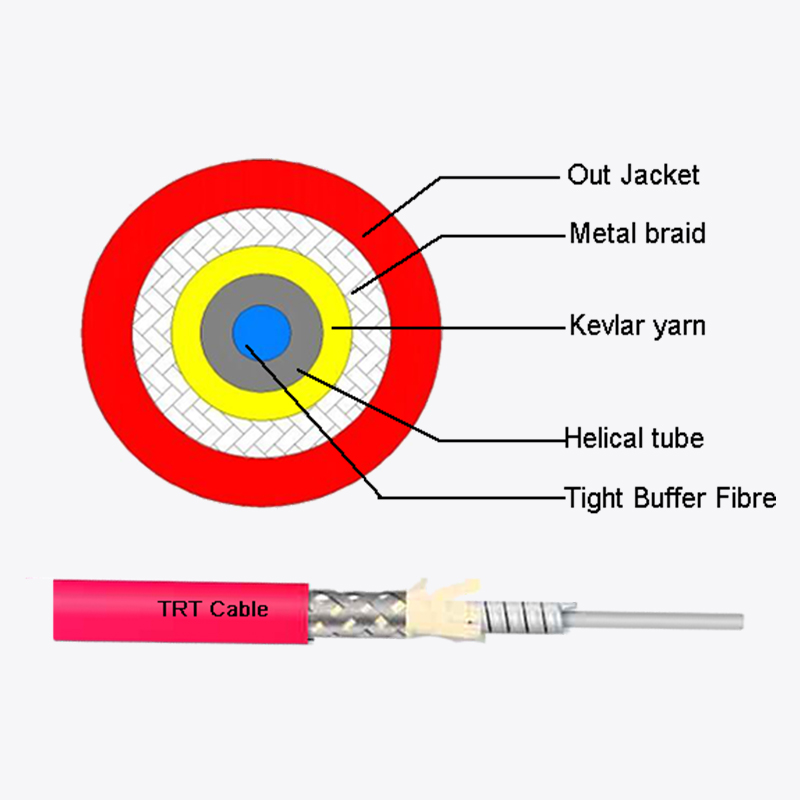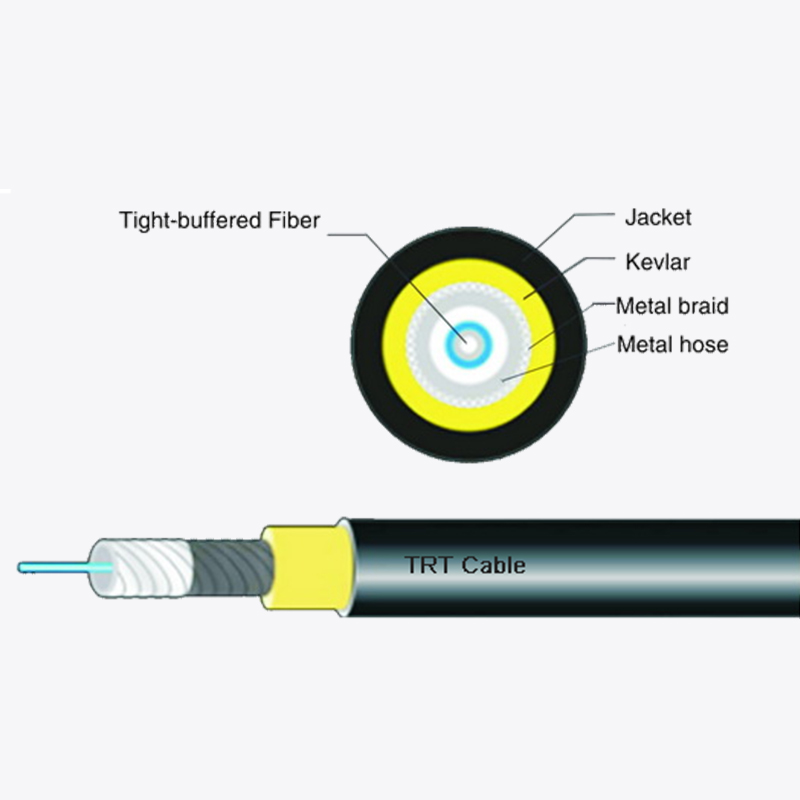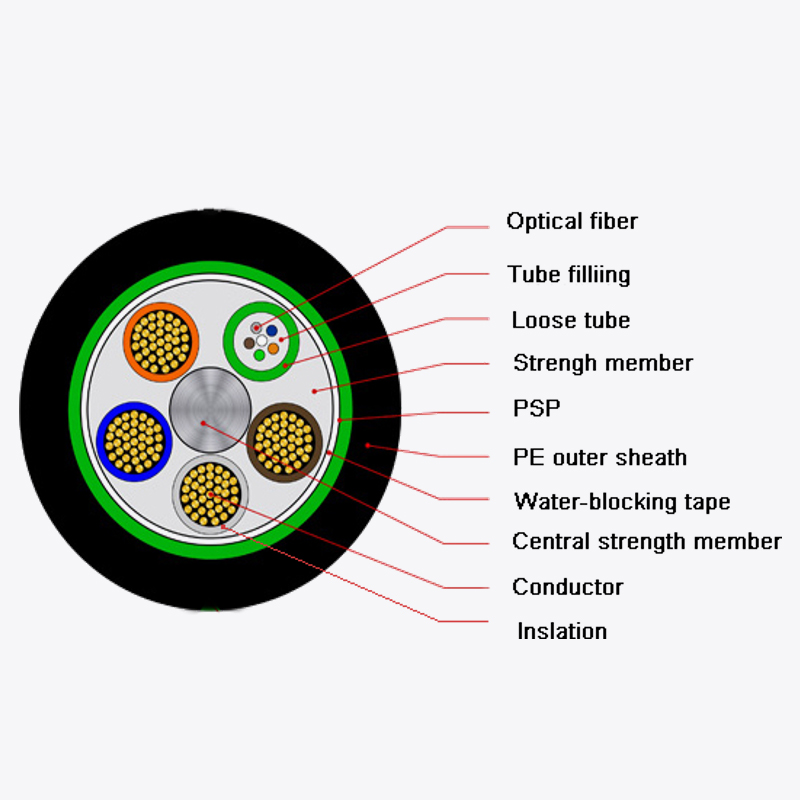Web Menu
Product Search
Exit Menu
How does simplex fiber optic cable achieve efficient and stable communication?

How does simplex fiber optic cable achieve efficient and stable communication?
The basic structure of simplex fiber optic cable
As a key component in the field of optical communication, the core of simplex fiber optic cable uses a single or tight-buffered optical fiber as the optical communication medium. Tight-buffered optical fiber is made of bare optical fiber by direct secondary coating with materials such as PVC, PVDF, LSZH, etc. through a special process. This structural design makes the optical fiber have good flexibility and can be flexibly wired in complex environments. The tight-buffered optical fiber is wrapped with a layer of aramid yarn, which is not an ordinary material. Aramid, the full name of “polyphenylene phthalate”, is a new type of high-tech synthetic fiber. It has a low density, but has a very high tensile modulus and breaking strength. It can maintain inherent stability in high temperature environments, has extremely low shrinkage, low creep and ultra-high glass transition temperature, and has strong chemical resistance except for strong acids and alkalis. The yarn made of aramid is wrapped around the outside of the optical fiber, giving the optical cable excellent tensile strength, effectively resisting external mechanical stress such as stretching and twisting, ensuring the integrity of the optical fiber under various complex working conditions, and thus ensuring that the optical signal transmission is not affected. The outermost layer of the optical cable sheath is made of PVC or LSZH material. PVC is polyvinyl chloride, which has good flexibility and processing performance and can effectively protect the internal structure; LSZH is a low-smoke halogen-free material with low-smoke, halogen-free and flame-retardant properties. While ensuring the basic protection function of the optical cable, it is more in line with environmental protection and safety requirements.
Characteristics and advantages of tight-buffered optical fiber
One of the significant advantages of tight-buffered optical fiber is that it is easy to strip. In actual engineering applications, whether it is connecting optical fibers to various optical active or passive devices, or making pigtails for connecting instruments and terminal equipment, the optical fiber needs to be terminated. Due to its special structure, tight-buffered optical fiber is extremely easy to strip the secondary coating. Compared with other types of optical fibers, it greatly saves termination time and labor costs, and improves construction efficiency. Flame retardant performance is another excellent characteristic of tight-buffered optical fiber. Take the tight-buffered optical fiber made of LSZH material as an example. It has flame retardant properties. When encountering a fire source, it can effectively prevent the spread of flames and reduce the risk of fire. In areas such as indoor riser layers and ventilation rooms where the space is relatively closed and personnel and equipment are dense, once a fire occurs, the fire can easily spread rapidly with the help of cables and other materials. The excellent flame retardant properties of tight-buffered optical fiber play a key role at this time, which can delay the spread of fire, buy precious time for personnel evacuation and fire fighting and rescue, and protect the safety of life and property. Its low smoke and halogen-free characteristics during the combustion process also avoid the generation of a large amount of toxic and harmful smoke, reducing damage to the human respiratory tract and equipment.
The key role of aramid yarn reinforcement components
Aramid yarn, as a reinforcement component, greatly enhances the tensile strength of the cable. In practical applications, optical cables often need to be laid in various complex environments, and they will be subjected to different degrees of tensile force during the process. If the tensile strength of the optical cable is insufficient, the optical fiber may break due to excessive force, resulting in communication interruption. With its high strength and high modulus, aramid yarn can withstand huge tensile forces, evenly disperse external forces, and prevent the optical fiber from being directly subjected to excessive stress. For example, in long-distance communication trunk lines, simplex fiber optic cables need to cross complex terrains such as mountains and rivers. Aramid yarn reinforcement components ensure that the optical cable can still maintain structural integrity and stably transmit optical signals under long-term and complex external forces, becoming a solid line of defense to ensure the reliable operation of the communication network.
Application scenarios of simplex fiber optic cable
In the indoor riser layer and ventilation room layer inside the building, the space is usually narrow and the environment is complex, and the installation convenience and fire safety of the cable are extremely high. The tight-buffered optical fiber of simplex fiber optic cable is easy to strip, which is convenient for wiring and termination operations in limited space; the flame-retardant sheath material it uses can effectively reduce fire hazards and ensure the safety of indoor personnel and equipment. The compact and lightweight design makes it easy to arrange in crowded cable racks, meeting the stringent requirements for cable distribution in complex indoor environments and ensuring the stable operation of indoor communication networks. In the field of instrumentation and communication equipment, accurate and high-speed data transmission is essential. Simplex fiber optic cable uses a single or tightly buffered optical fiber as the medium, which can achieve high-bandwidth, low-loss optical signal transmission and meet the needs of high-speed, large-capacity data interaction between devices. Its stable transmission performance is not affected by electromagnetic interference, ensuring the accuracy of instrument measurement data and the reliability of communication equipment signals. Tight-buffered optical fiber is easy to connect to the equipment, and aramid yarn reinforcement components enhance the optical cable’s ability to resist external forces during frequent plugging and unplugging and movement, ensuring long-term stable operation of equipment interconnection lines.
 Address:Zhong'an Road, Puzhuang Town, Suzhou City, Jiangsu Prov., China
Address:Zhong'an Road, Puzhuang Town, Suzhou City, Jiangsu Prov., China Phone:+86-189 1350 1815
Phone:+86-189 1350 1815 Tel:+86-512-66392923
Tel:+86-512-66392923 Fax:+86-512-66383830
Fax:+86-512-66383830 Email:[email protected]
Email:[email protected] Wechat: xiaobin18913501815
Wechat: xiaobin18913501815 whatsapp: +86 18913501815
whatsapp: +86 18913501815
 0
0

 English
English русский
русский Español
Español Português
Português عربى
عربى



